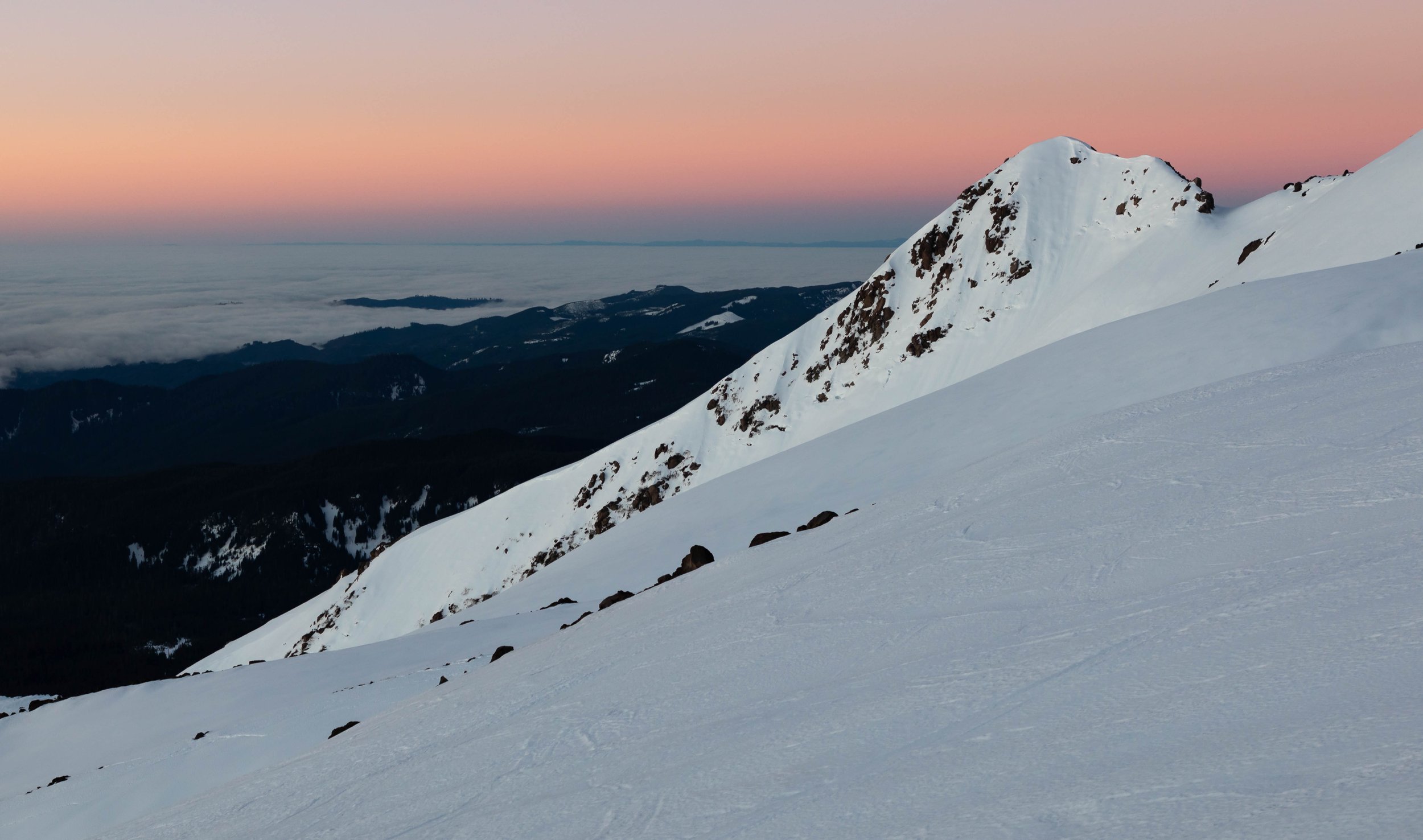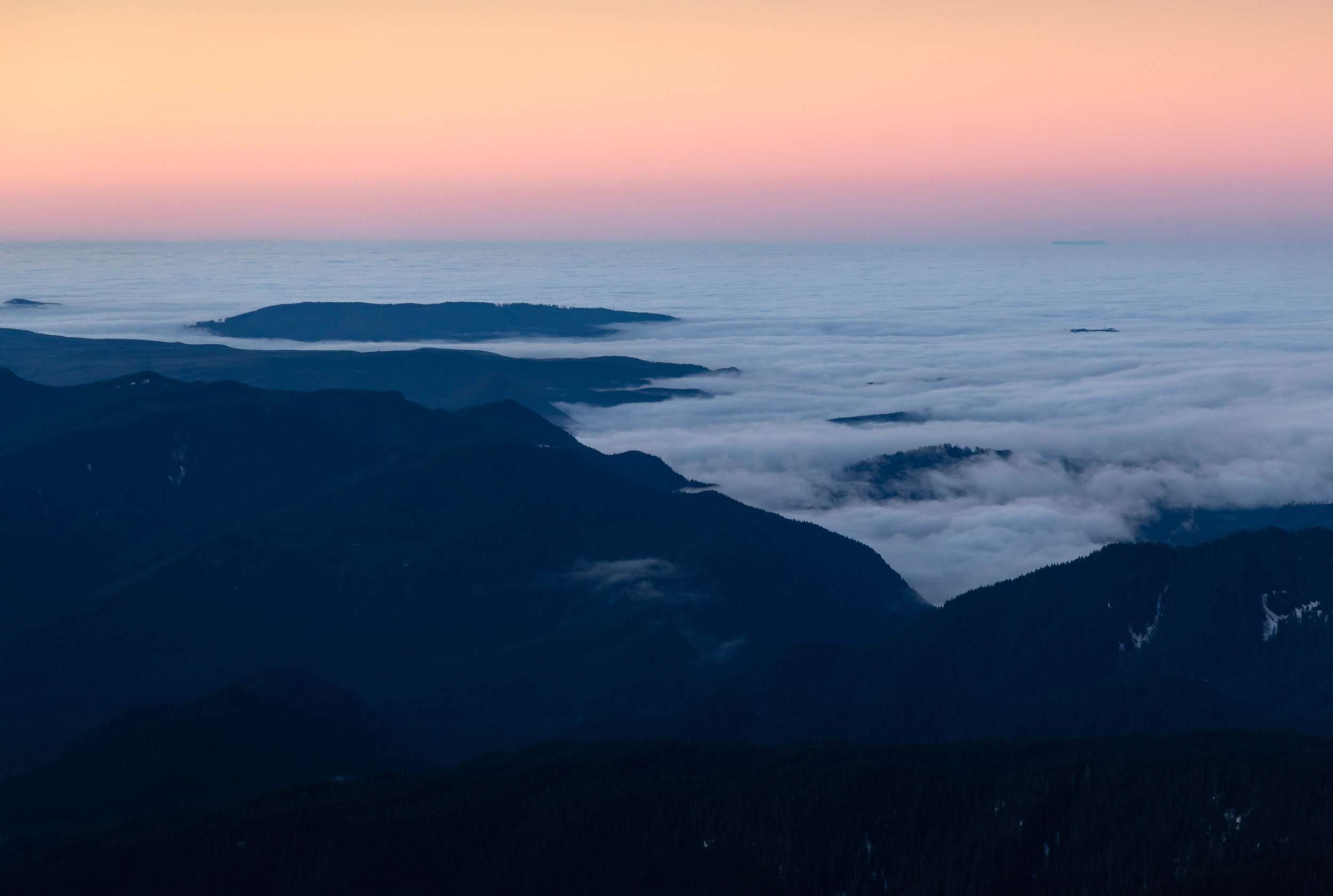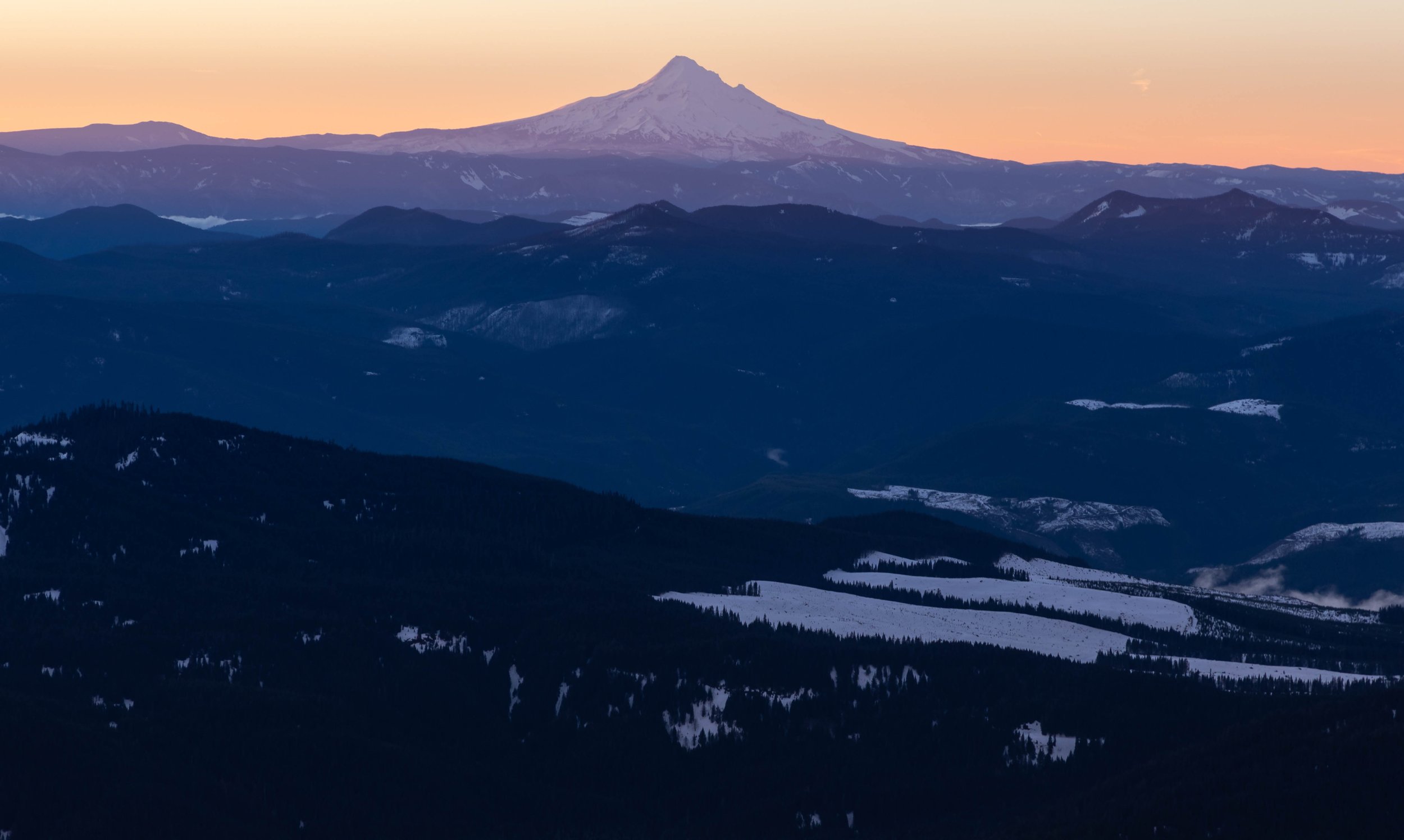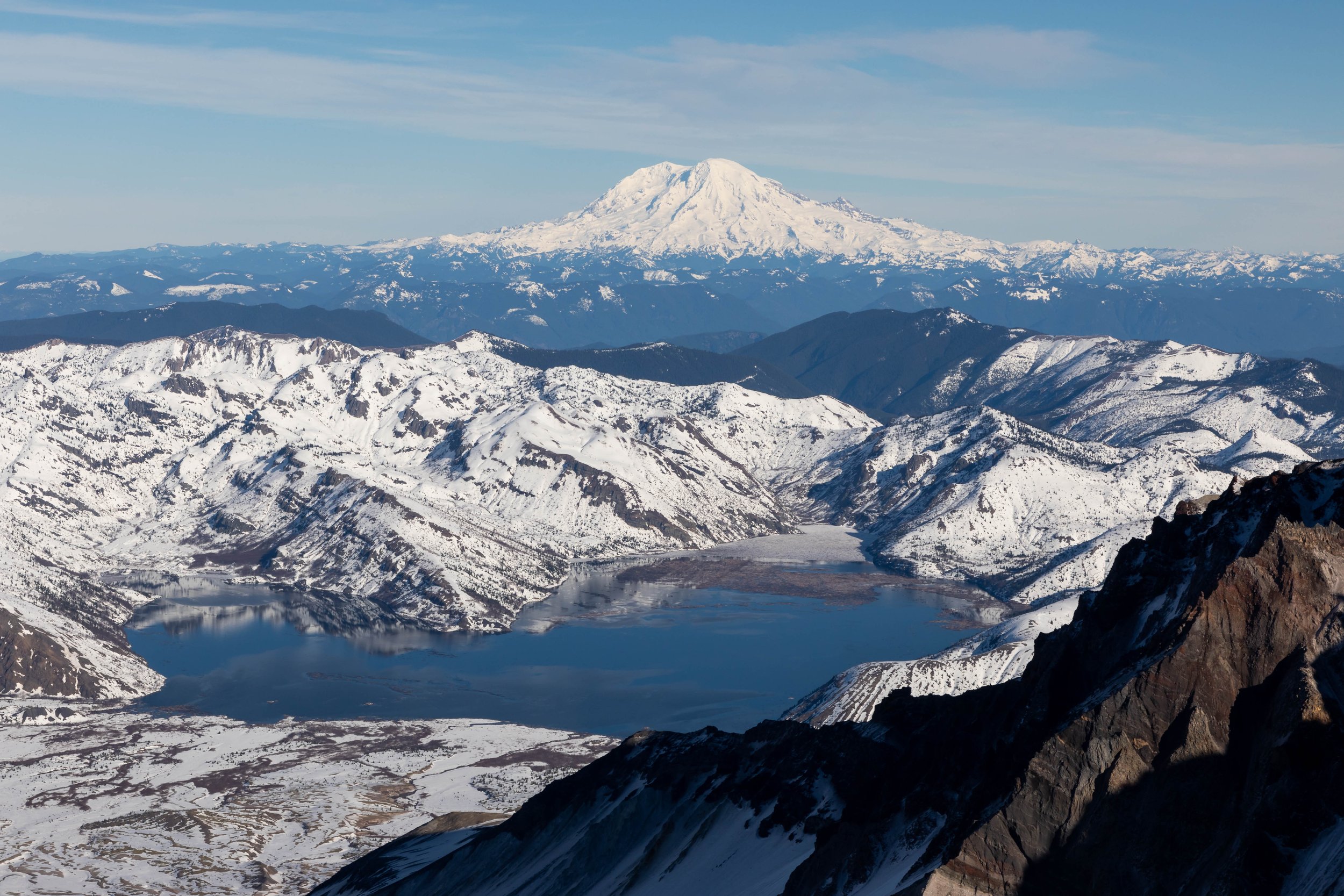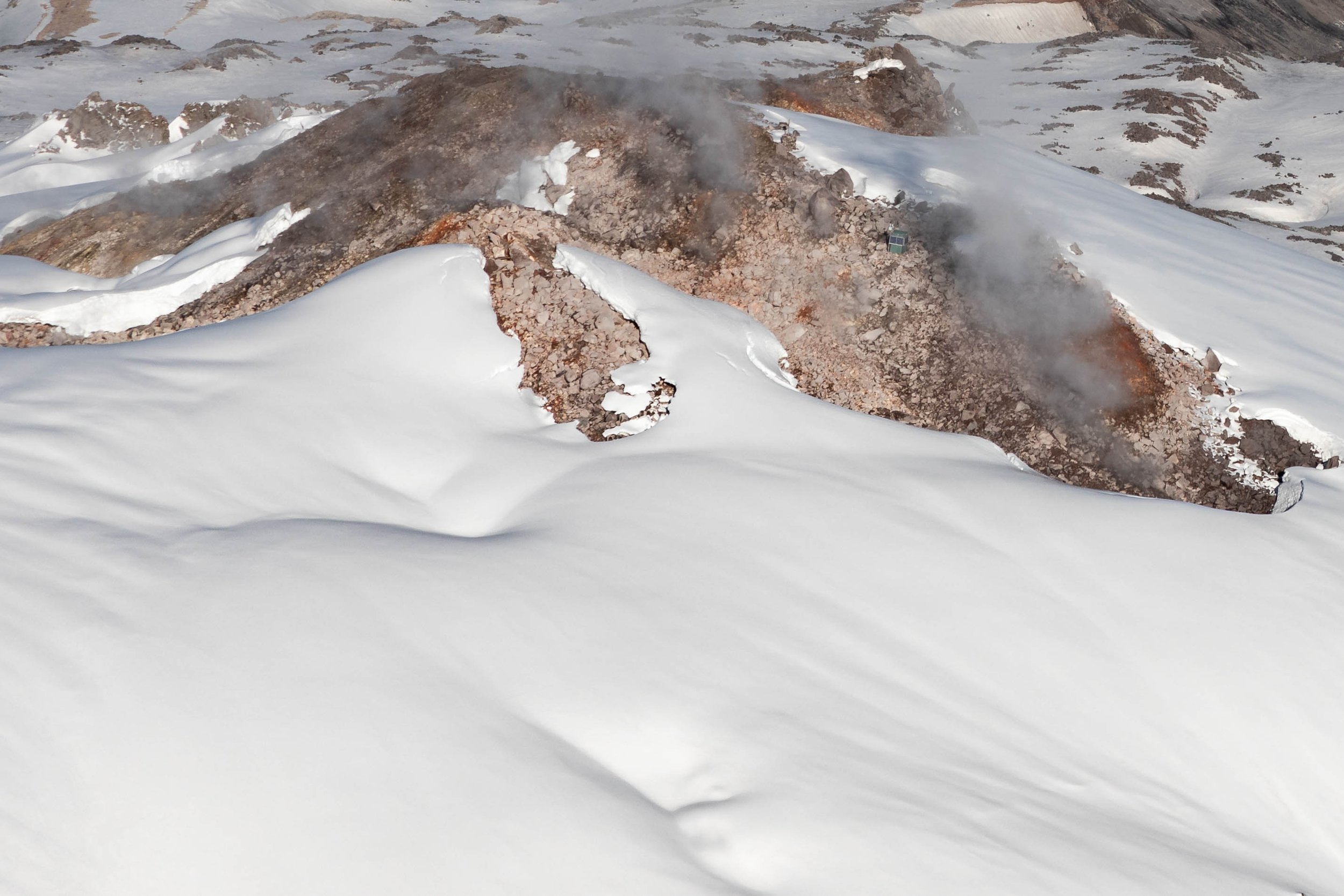Juneuary in Washington: Skiing Loowit
DATE HIKED: 1/22/22
TOTAL MILEAGE: 12 Miles
TOTAL ELEVATION GAIN: 5,600’
RED TAPE: Permits required. From November 1 through March 31 climbers can self-register for free at the trailhead. From April 1 through October 31 climbers need to secure a permit through Recreation.gov (from the site: “Permits are released in one month increments on the first day of the preceding month”)
This January offered a string of sunny, warm weekends with relatively low avalanche risk, resulting in many to dub the month Juneuary and head off on adventures usually relegated to the stabler spring months. Alex and I couldn’t let an opportunity to climb and ski a volcano in the depths of winter pass us by so we, too, headed for the mountains. We make it a goal to ski Loowit (Mount St. Helens) once per year and chose this for our Juneuary destination. It’s a beautiful climb with summit views clear into Oregon to the south and as far as Canada to the north, it’s a wildly enjoyable ski when conditions are right, and it’s a great way to train for some of our bigger spring objectives.
We picked up a Sno-Park pass from REI and started the 3.5 hour drive from Seattle early Friday afternoon. With the knowledge that the fair weather would lure in crowds, we wanted to assure that we had a spot in the lot and arrived comfortably at 7:30PM. There were already a few other cars and RVs parked but I was relieved to have no problem finding a space. We quickly prepped all of our gear to allow for a seamless morning and then went to work transforming our trunk into a nest to nap in until our 2:45AM alarms. We reclined the back seats and laid our sleeping bags and pillows with our heads toward the back. With the trunk closed this sleeping setup seems like it would be claustrophobic—and the first time we slept this way it certainly was—but I now love the total darkness that envelopes me. It makes falling asleep much easier and with extra comfortable pillows and padding, the setup isn’t terrible.
Alex making his way up the final slope to the crater rim
After only about four hours of sleep our alarms echoed simultaneously in the trunk, jolting us awake. We stayed warm in our sleeping bags throughout the night, but outside the car it was downright cold. The ground and all the cars were blanketed in a layer of sparkly frost. I desperately wanted to continue sleeping in the cozy car but we put on our layers and grabbed the gear we had set up just a few hours prior and headed to the trailhead to register our climb. It may have been the middle of the night but already the parking lot was beginning to buzz. A few other groups had already headed out before us and even more were getting ready.
We filled out the self-register permit and hit the icy trail. The weather forecast called for a balmy January day with highs in the 40s near the summit and in the 50s down low, but in the depths of the night the air was chilled and the ground remained frozen.
Our headlamps illuminated the way ahead of us and were assisted by a full, bright moon that hung in the sky and bathed the forest in a soft glow. It was nice to have further visibility than just the halos of our headlamps. We moved in silence, slowing making our way through the forest, the trees becoming ever more dispersed and intermittently offering us glimpses of the volcano we hoped to climb.
Chocolate Falls is what I consider the first checkpoint of the climb—a place to take a short break, reconfigure layers, rehydrate. It took us just over an hour to make it to the frozen waterfall and we were feeling strong so we continued on after only a brief break. I looked up toward our route. Headlamps were bobbing along the ridges far above us: climbers making their way up to the Weather Station (what I consider the second checkpoint of the climb). I had hoped to reach the Weather Station before sunrise. This would be our fourth sunrise on the mountain and we’ve discovered that the Weather Station is one of the best places (besides the summit, I would imagine) to watch the burgeoning new day.
A climber making their way to the weather station at dawn
One foot in front of the other. Up, up, and up we followed the ridge. The wind roared in our ears as we hiked. What had started as a benign breeze above Chocolate Falls continued to grow into fierce gusts with each step. Thankfully it was a warm wind. I already had nearly all of my layers on and if it were a cold wind we may have been forced to retreat back into the shelter of the forest until the sun rose.
We passed a few groups taking breaks along the way, but we were determined to make it to the Weather Station before breaking. We accomplished our goal and took the last few steps up the steep slope preceding the Weather Station while it was nautical twilight. The sky’s darkness had faded ever so slightly, all but the brightest stars had dimmed, and the edges of the horizon were beginning to glow a deep orange.
I threw my pack down and took out my final layer (the warmest down jacket I own) to stave off the relentless wind. We took a half an hour break at the Weather Station, eating snacks and watching the sun slowly paint the sky orange and pink.
Just as the sun crested the horizon, we set off from the Weather Station. The wind dropped significantly after sunrise, which was a change in conditions appreciated by everyone we met on the mountain. After climbing about one hundred vertical feet I looked over at Alex and noticed that he appeared to be limping—not a good sign with still nearly 3,000’ to climb.
“Are you okay?” I called over. Alex replied with a dejected “No.” He said his calf was really tight and painful. We reconvened near some rocks and ultimately decided that he would wait there while I continued upward. He would stretch his calf, take some ibuprofen, and see if an extended break lessened the pain, but he wasn’t feeling confident in his chances of continuing the climb.
I was incredibly disappointed to have to continue the climb on my own. It’s not that I thought I couldn’t do it on my own, I knew I could. I’d already completed the climb two times previously and knew the route well. I just really love completing these climbs with Alex, my partner. It almost felt like if he wasn’t going to climb, I didn’t want to climb either. But, I was feeling strong and confident and wanted to make it to the top so I pushed onward solo.
The views as the sun rose were a welcome distraction from the strenuous and steep climb. Shadows played upon the ridges and recent rains created faint runnels in the slopes. No matter how many visits I make, each time the conditions are just different enough to make each trip feel novel. Offer a new view, a new experience.
Suddenly the BCA Radio I was wearing on my backpack strap crackled to life, “What elevation are you at?” Alex asked.
I pulled up my Gaia app on my phone and checked the elevation, “I’m at 6,900 feet.”
“I’m only 700 feet below you!” Alex responded over the air. He said that the break had helped significantly and he was resuming the climb, taking a more zig-zag approach up the hill to lessen the strain on his calf.
I broke into a smile. We would get to summit together after all!
About 300’ shy of the summit I found the first flat-ish spot I had seen in at least 1,000’ and decided to pause and wait for Alex so we could take the last steps to the top together. I sat on my pack and watched as climbers passed me, bound for the summit. Eventually, I spied Alex’s telltale skis bobbing just below a ridge, and a few seconds later he climbed into view. He took a brief break where I had stopped and we talked about each of our climbs thus far before making the final push to the top.
Twenty minutes later we were on the crater rim. It was clear, windless, warm, and crowded! Bluebird winter weekends draw in skiers and climbers from all over Washington and Oregon and it seemed as if everyone was taking an extended break on the rim. I had initially hoped to make it to the true summit on this climb, which requires another couple of hundred feet of climbing, but the snow conditions at the top were much more icy than I had anticipated and I didn’t want to push it too much in that terrain. I’ll have to save that goal for next time!
Despite not making it to the true summit, the views from the crater rim were stunning. To the north, the caldera was spewing steam far below us, Mt. Rainier seemed to loom over Spirit Lake. And to the south we could see clear into Oregon with views of Mt. Hood, Mt. Jefferson, and even the Sisters.
Immediately after making it to the rim we realized the snow at the top was still far too icy and firm to attempt to ski, so we decided to wait for an hour or two to see if the bright sun would soften the snow at all. We waited, and waited, and waited. Climbers had no problem heading down as the snow conditions didn’t need to be soft for them, but more skiers continued to gather on the rim, patiently—perhaps futilely—waiting for the snow conditions to improve. At about 12:30 it seemed as if the rim was standing room only. Groups were crowded together and a long line of skiers were on the final approach, yet there was so little room for them at the top. Alex and I knew that the snow conditions were less than ideal, but we also knew that waiting another thirty minutes likely wouldn’t make much of a difference. So we decided to gear up and head down.
The first few turns from the rim were bone-chattering as our skis bounced over the icy slope trying to grab purchase on frozen ground. My skis were chattering so loudly it sounded as if someone were trying to construct a building right below me!
1,000’ below the rim, the ice finally gave way to something resembling snow. Alex and I carved down smooth slopes, over ridges, and into gulleys as we made our way down the mountain. Even in less than ideal skiing conditions, the ski from the top of the crater rim back to the trailhead off Mount St. Helens is one of my all-time favorite skis. The views are incredible and the terrain is just so fun.
Finally, we made it back to Chocolate Falls and into the home stretch. The forested section of the trail turns into somewhat of a luge in the afternoons, which makes for one fast and enjoyable run back to the car. What took us an hour to skin up, took us only about ten minutes to ski back down. The trees whizzed by in a green blur, until suddenly, the trailhead came into view through the forest. I skied right up until the pavement before clicking out of my skis.
This trip marks the third time Alex and I have made it to the crater rim. I am bummed to not have stood on the true summit yet, and I had high hopes to make that climb this trip, but it looks like we’ll just have to come back again. Perhaps even later this season!
Two skiers make their way to the true summit (as viewed from the crater rim)




